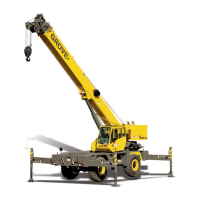Manitowoc Published 06-24-16, Control # 241-01 2-11
2250 OPERATOR MANUAL SAFETY INFORMATION
Attaching the Load
• Attach the hook to the load with slings, or other suitable
rigging. Each hook must have a latch that is in proper
working order. Hook latches must not be wired open.
- Inspect each hook and latch before using.
- Never use a hook or latch that is distorted or bent.
- Make sure the spring will force the latch against the
tip of the hook.
- Make sure the hook supports the load. The latch
must never support the load. Latches are only
intended to retain loose slings under slack
conditions.
• Only use slings and other rigging that are in safe
operating condition and have a rating equal to or greater
than the load to be lifted.
• Do not wrap the load line around the load.
• Use suitable protection between slings and any sharp
edges on the load. When synthetic slings are used, the
synthetic sling manufacturer's instructions, limitations,
specifications, and recommendations must be followed.
• Secure unused legs of a multi-leg sling before handling
a load with one leg of sling.
Lifting/Moving the Load
Before lifting or moving a load, the operator or qualified
person directing the lift shall make the following checks:
o The crane has a firm, uniformly supporting foundation
under all crawlers. Unless otherwise specified in the
capacity chart, the foundation must be level to within
1%—0,3 m (1ft) rise or fall in a 30,5 m (100 ft) distance.
When such a surface is not available, it must be
provided with timbers, cribbing, or other structural
members to distribute the load so that the allowable
bearing capacity of the underlying member is not
exceeded.
NOTE: For ground bearing data go to:
http://www.manitowoccranes.com/en/Resources/
tools/ground-bearing-pressure
o The load is secured and properly balanced in the slings
or the lifting device before lifting the load more than 76 to
152 mm (3 to 6 in).
o The lift and swing paths are clear of personnel and
obstructions.
o The load is free to be lifted.
o The load line is not kinked or otherwise damaged.
o Multiple part load lines are not twisted around each other
in such a manner that the lines will not separate when
the load is lifted.
o The hook is brought over the load in a manner that will
minimize twisting or swinging.
o The load line and the boom hoist rope are properly
spooled on the drums and seated in the sheaves.
o The load drum brakes are in proper working order.
The operator shall test the load drum brakes each time a
load approaching the rated load is handled. Lift the load
76 to 152 mm (3 to 6 in) and fully apply the brakes.
NOTE: The load must not lower through applied brakes.
o Unused load drums are parked (working and parking
brakes applied, drum pawls engaged, if equipped).
o All personnel are clear of the swing radius of the crane’s
counterweight.
While lifting or moving the load, the operator shall take the
following precautions:
• Accelerate and decelerate the load smoothly to avoid
excessive stress on the crane boom and machinery.
• Avoid sudden starts and stops while swinging. Keep the
swing speed under control to prevent the load from
swinging out beyond the radius at which the load can be
handled and to minimize the pendulum action of the
load.
• Sound the signal horn before swinging and intermittently
while swinging, especially when approaching personnel.
If equipped, the automatic swing alarm will sound when
the crane is swung.
• Use taglines or other restraints to control the load when
necessary.
• Do not exceed any swing limitations (areas of operation)
given in the Capacity Chart.
• Do not allow the load, the boom, or any other part of the
crane to contact obstructions.
• Do not use the crane to drag a load.
• Do not hoist, lower, or swing the load while personnel
are on the load or hook. See Personnel Handling Policy
on page 2-25.
• Avoid carrying the load over personnel. Loads that are
suspended must be blocked or cribbed before personnel
are allowed to work under or between them.
